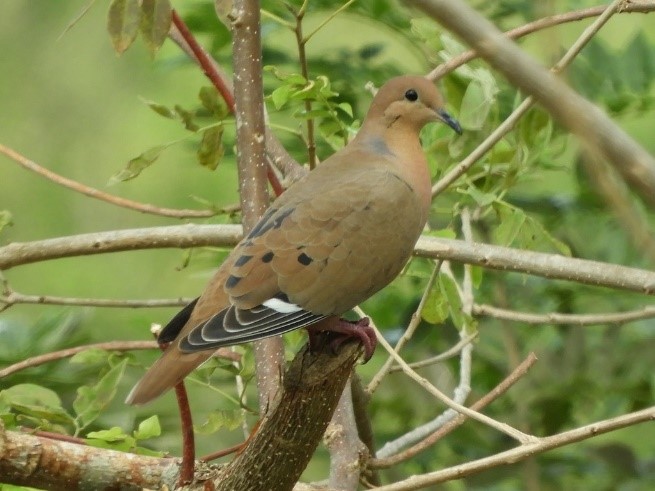Birdfinding.info ⇒ One the most ubiquitous and quintessentially West Indian birds, it is common and generally easy to find across nearly all of its range—i.e., throughout the West Indies—with a few local exceptions. The arrival of White-winged Doves on Grand Cayman largely displaced it there, but it appears to be returning. In the northern Bahamas, it is common on Abaco and Andros, but scarce on Grand Bahama and New Providence. In Mexico, it has increased in the 2000s, and can now be found all along the Mexican Riviera. The handful of modern Florida records seem to be centered on Key Largo.
Zenaida Dove
Zenaida aurita
Endemic to the West Indies and Yucatán Peninsula, where it occurs in various open, semi-open, and wooded habitats, including urban areas.
From Cuba and Grand Bahama south to the Cayman Islands and east through the Virgin Islands and Lesser Antilles south to Grenada and Barbados.
Salvadorii occurs mainly in arid coastal scrub of the northern Yucatán Peninsula (from the northernmost tip of Campeche to the Cancún area, and spreading south to Sian Ka’an Biosphere Reserve) and adjacent islands. Also occurs locally or sporadically in the interior of Yucatán and northern Quintana Roo.
Status in Florida. Historically resident on the Florida Keys until the early 1800s. There were very few Florida records in the 1900s, then an apparent increase in the 2000s, possibly suggesting a trend toward recolonization—although the increase in records may be due mainly to increased awareness.
Identification
Similar overall to Eared and Mourning Doves, lacking Mourning’s long tail. Among these closely related species, Zenaida’s key diagnostic feature is the white tips of the secondaries, noticeable as a white trailing edge on spread wing or a white bar or check on folded wing.
Zenaida Dove’s three subspecies are usually separable in the field. The most widespread subspecies, Z. a. zenaida, is the plainest and darkest overall. Further differences are discussed below.
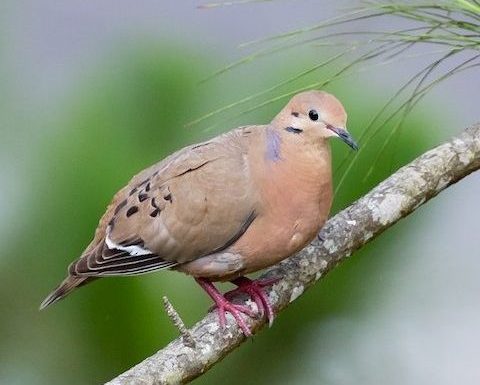
Zenaida Dove, Z. a. zenaida—note the diagnostic white bar on the wing. (Ranch Vegas, Cayey, Puerto Rico; June 16, 2019.) © José Santiago

Zenaida Dove, Z. a. zenaida—note the diagnostic white check on the wing. (Guajataca, Puerto Rico; March 22, 2017.) © Frédéric Pelsy
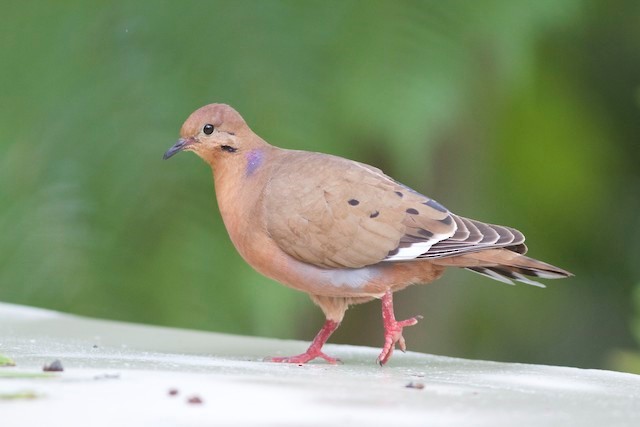
Zenaida Dove, Z. a. zenaida, showing a white bar on the wing and gray flanks. (El Yunque National Forest, Puerto Rico; May 5, 2017.) © Doug Hitchcox
Overall coloration is sandy-brown on the upperparts, becoming rich buffy-brown on the head, neck, and underparts. The flanks are typically gray, but are often concealed by the folded wing.
The Lesser Antillean aurita differs noticeably in having an extensively white belly. However, there is a spectrum and some individuals appear to have essentially the same belly coloration as the Greater Antillean zenaida.

Zenaida Dove, Z. a. zenaida, showing the rich buffy-brown head, neck, and underparts typical of this subspecies. (Montego Bay, Jamaica; March 20, 2016.) © Raúl Vega
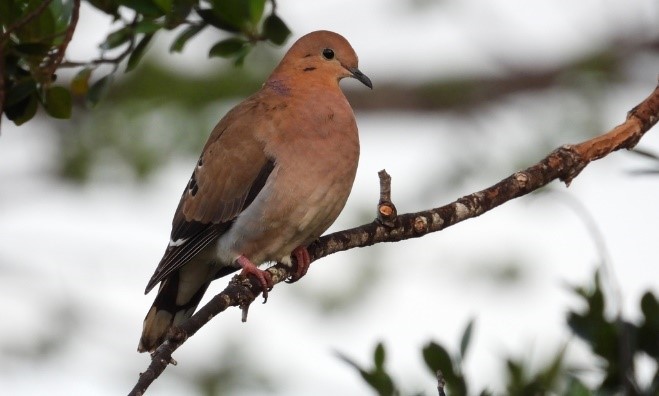
Zenaida Dove, Z. a. aurita., showing gray flanks and a mostly buffy belly, atypical for this subspecies. (Sion Hill, Barbados; January 5, 2019.) © Grete Pasch

Zenaida Dove, Z. a. salvadorii, showing buffy belly and gray flanks typical of this subspecies—also note the atypically extensive white on the wings. (Isla Mujeres, Quintana Roo, Mexico; February 17, 2019.) © Felipe Eduardo San Martín González
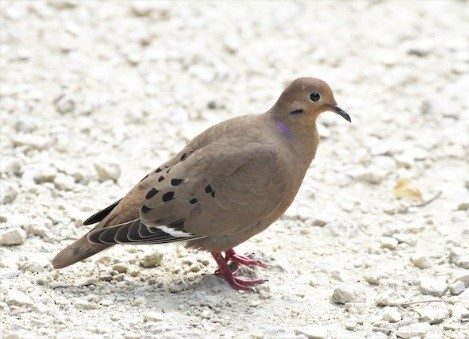
Zenaida Dove, Z. a. zenaida, in plain-brown plumage. (Queen Elizabeth II Botanic Park, Grand Cayman; March 2, 2018.) © Charles Davies
As with its close relatives, Zenaida Dove has a short, bold, black whisker stripe below and behind the eye. A thinner black line is sometimes present behind the eye.
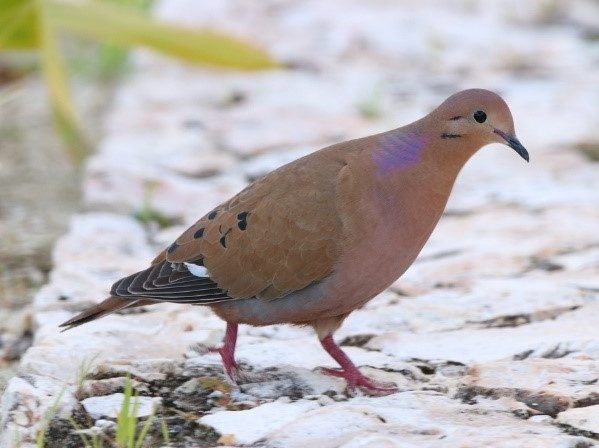
Zenaida Dove, Z. a. zenaida, showing gray flanks and lilac iridescence on the sides of the neck. (Runaway Bay, Jamaica; February 16, 2018.) © Mountain West Birding Company

Zenaida Dove, Z. a. aurita—an extreme example of this subspecies’s characteristically white belly—also molting its tail feathers. (St. George, Grenada; March 2, 2017.) © Vikki Jones

Zenaida Dove, Z. a. aurita, showing the white belly typical of this subspecies. (St. Thomas, Barbados; November 12, 2016.) © Lewis Gray

Zenaida Dove, Z. a. aurita, in rich breeding colors and showing the white belly typical of this subspecies. (St. John’s, Antigua; April 12, 2018.) © Bird Explorers

Zenaida Dove, Z. a. aurita, with a buffy belly, atypical for this subspecies. (St. John Figtree, Nevis; March 12, 2018.) © Steven Mlodinow

Zenaida Dove, Z. a. salvadorii, showing buffy belly and gray flanks typical of this subspecies. (Tizimín, Yucatán, Mexico; November 8, 2015.) © José Antonio Linage Espinosa

Zenaida Dove, Z. a. zenaida, with a black line behind the eye—note that this individual’s tail is forked due to molt. (Rancho Vegas, Cayey, Puerto Rico; June 24, 2018.) © José Santiago
As in other doves, the coloration of its plumage varies in intensity depending on age, sex, and reproductive status.
Males in breeding plumage show vivid pink or lilac iridescence on the sides of the neck, less so on the cap, nape, and mantle. The neck patches appear grayish in some lighting conditions.

Zenaida Dove, Z. a. aurita, in rich breeding colors and showing the white belly typical of this subspecies. (Dominica; April 28, 2013.) © Tauscher Gerhard

Zenaida Dove, Z. a. aurita, with its neck patch appearing gray due to the lighting. (Timothy Beach, St. Kitts; March 3, 2018.) © Steven Mlodinow
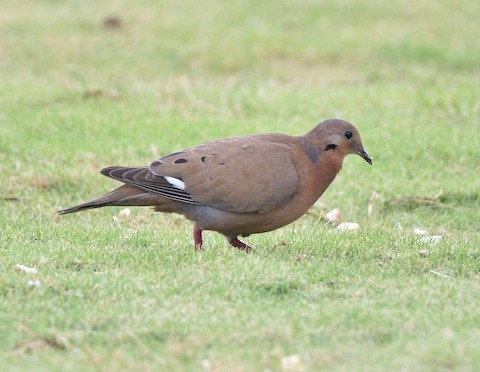
Zenaida Dove, Z. a. zenaida, with its neck patch appearing gray due to the lighting. (Windsor, Jamaica; March 20, 2016.) © Bill Chambers
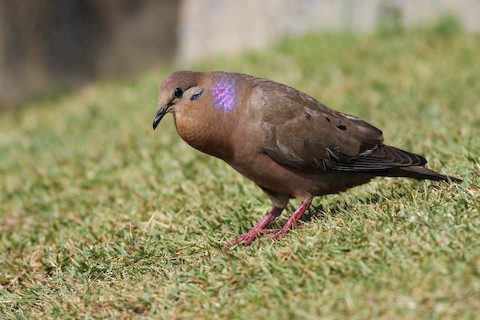
Zenaida Dove, Z. a. zenaida, apparently a male in breeding condition, but with limited spotting on wings. (El Morro, Old San Juan, Puerto Rico; March 20, 2017.) © Alex Lamoreaux
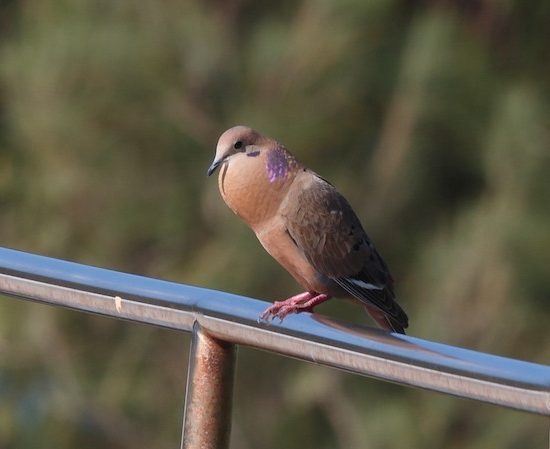
Zenaida Dove, Z. a. zenaida, male, fully inflated, showing pink neck patchers. (Parque Luis Muñoz Rivera, San Juan, Puerto Rico; February 13, 2016.) © Simon Best
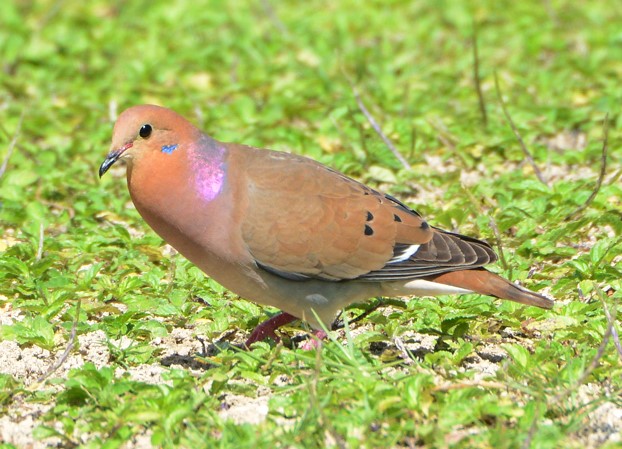
Zenaida Dove, Z. a. aurita, showing pink iridescent patches on the side of the neck but limited black spots on the wings. (Martinique; February 2014.) © Jean-Claude Jamoulle
Typically has several blackish spots on the wing coverts and tertials, though some (perhaps mostly but not always younger birds) have few or no spots.
In the Lesser Antillean aurita these are often fringed with white, especially on males in breeding plumage.

Zenaida Dove, Z. a. zenaida, with plain-brown coloration and extensive black spots on wing coverts and tertials—also note the diagnostic white check on the wing. (Long Key State Park, Florida; April 2, 2016.) © Bert Filemyr

Zenaida Dove, Z. a. salvadorii, showing black spots on wing coverts and tertials. (Ría Lagartos, Yucatán, Mexico; September 15, 2013.) © Rolando Chávez
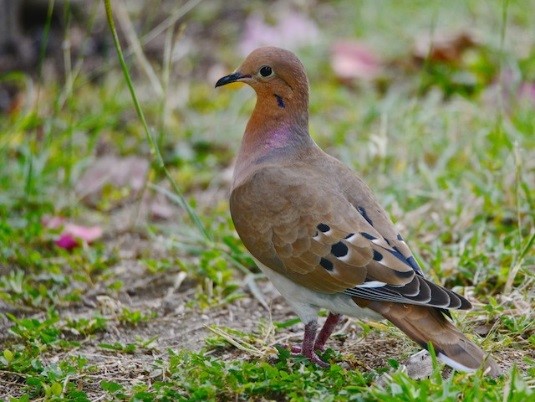
Zenaida Dove, Z. a. aurita, showing white fringes on black wing-spots. (Mount Hartman National Park, Grenada; March 15, 2015.) © Alan Van Norman
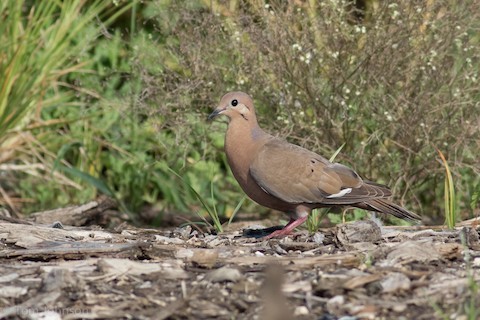
Zenaida Dove, Z. a. zenaida, immature, showing very limited spots on its wings. (West Kendall Agricultural Area, Miami, Florida; July 31, 2018.) © Tom Johnson
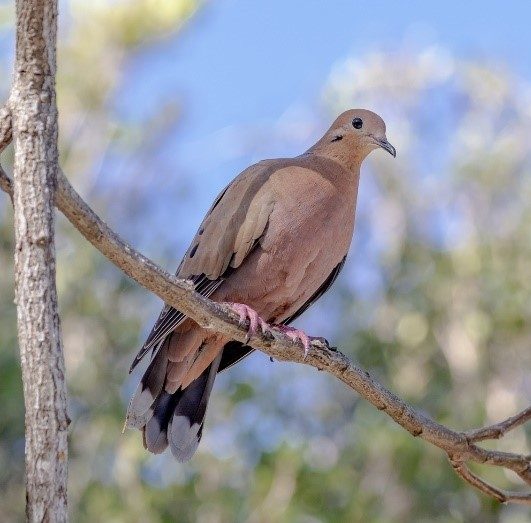
Zenaida Dove, Z. a. zenaida, showing grayish tips on undertail. (North Side, Grand Cayman; February 11, 2019.) © Nancy Norman
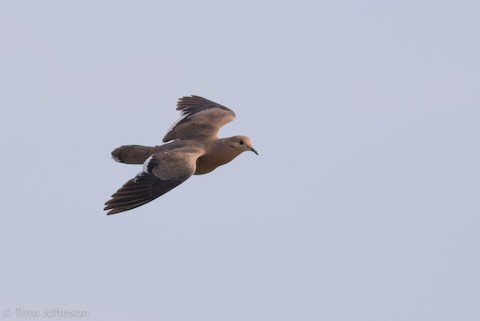
Zenaida Dove, Z. a. zenaida, showing rounded tail and white trailing edge on secondaries. (West Kendall Agricultural Area, Miami, Florida; July 31, 2018.) © Tom Johnson
The tail is rounded and usually appears all-brown or blackish when folded.
When spread or seen from below, however, the tail shows a black subterminal band and is broadly tipped with gray (on the Greater Antillean zenaida) or white (on the Lesser Antillean aurita and Mexican salvadorii).

Zenaida Dove, Z. a. aurita, showing white tips on undertail. (Sainte-Anne, Martinique; March 30, 2016.) © Jean-Luc Baron

Zenaida Dove, Z. a. zenaida, show gray flanks and pale underwings with trailing edge on secondaries. (West Kendall Agricultural Area, Miami, Florida; July 9, 2018.) © Alex Lamoreaux
Cf. Mourning Dove. Mourning and Zenaida Doves occur together across most of the Caribbean region and are readily confused under some circumstances. They appear nearly identical in most respects, with the exceptions of their tails and wing markings. Most Mourning Doves are immediately recognizable by their long, pointed tails, but during molt periods this feature disappears or becomes indistinct.
Under all circumstances, Zenaida Dove can be distinguished from Mourning by the white tips of its secondaries, which is visible in flight as a white-trailing edge on the inner wing. At rest, the white tips are usually visible as an isolated white patch on the folded wing.
Cf. Eared Dove. Eared and Zenaida Doves occur together in the Lesser Antilles. They can be essentially indistinguishable under some circumstances. The key distinction is Zenaida Dove’s white-tipped secondaries.
Notes
Polytypic species consisting of three recognized subspecies: zenaida (Greater Antilles to the Virgin Islands) aurita (Lesser Antilles from Anguilla south), and salvadorii (Yucatán Peninsula).
The Zenaida Dove is the national bird of Anguilla.
References
Alderfer, J., and J.L. Dunn. 2014. National Geographic Complete Birds of North America (Second Edition). National Geographic Society, Washington, D.C.
Baptista, L.F., P.W. Trail, H.M. Horblit, P. Boesman, G.M. Kirwan, and E.F.J. Garcia. 2019. Zenaida Dove (Zenaida aurita). In Handbook of the Birds of the World Alive (J. del Hoyo, A. Elliott, J. Sargatal, D.A. Christie, and E. de Juana, eds.). Lynx Edicions, Barcelona. https://www.hbw.com/node/54208. (Accessed September 15, 2019.)
BirdLife International 2016. Zenaida aurita. The IUCN Red List of Threatened Species 2016: e.T22690750A93286821. http://dx.doi.org/10.2305/IUCN.UK.2016-3.RLTS.T22690750A93286821.en. (Accessed September 15, 2019.)
Bond, J. 1979. Birds of the West Indies (Fourth Edition). Collins, London.
eBird. 2019. eBird: An online database of bird distribution and abundance. Cornell Lab of Ornithology, Ithaca, N.Y. http://www.ebird.org. (Accessed September 15, 2019.)
Garrido, O.H, and A. Kirkconnell. 2000. Field Guide to the Birds of Cuba. Cornell University Press, Ithaca, N.Y.
Gibbs, D., E. Barnes, and J. Cox. 2001. Pigeons and Doves: A Guide to the Pigeons and Doves of the World. Yale University Press, New Haven, Connecticut.
Haynes-Sutton, A., A. Downer, R. Sutton, and Y.-J. Rey-Millet. 2009. A Photographic Guide to the Birds of Jamaica. Princeton University Press, Princeton, N.J.
Howell, S.N.G., I. Lewington, and W. Russell. 2014. Rare Birds of North America. Princeton University Press, Princeton, N.J.
Howell, S.N.G. and S.W. Webb. 1995. A Guide to the Birds of Mexico and Northern Central America. Oxford University Press, Oxford.
Latta, S., C. Rimmer, A. Keith, J. Wiley, H. Raffaele, K. McFarland, and E. Fernandez. 2006. Birds of the Dominican Republic and Haiti. Princeton University Press, Princeton, N.J.
Raffaele, H. 1989. A Guide to the Birds of Puerto Rico and the Virgin Islands. Princeton University Press, Princeton, N.J.
Raffaele, H., J. Wiley, O. Garrido, A. Keith, and J. Raffaele. 1998. A Guide to the Birds of the West Indies. Princeton University Press, Princeton, N.J.
